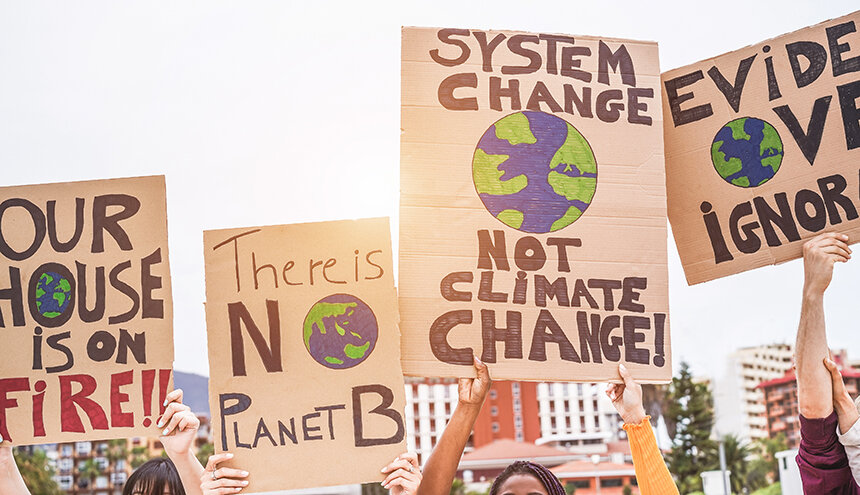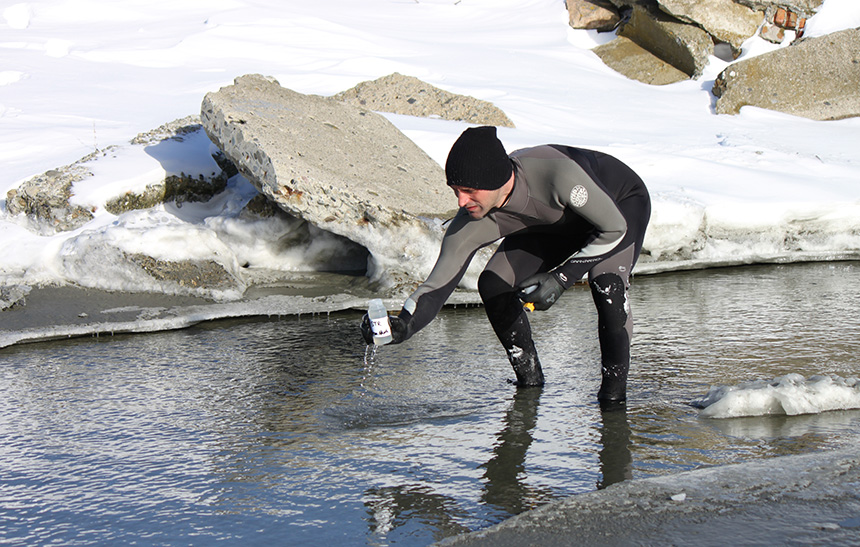Elixir of Life Faces Steady Stream of Contamination
From PFAS pollution to the challenges presented by climate change, drinking water woes impact disenfranchised communities at much greater extent
July 18, 2022

Wanda Hopkins only spoke for a few minutes at the Rhode Island Environmental Education Association’s 2022 Annual Summit, but she uttered a three-word phrase that is undeniable: “Water is sacred.”
“Our waterways are very important. They are sacred,” the Narragansett Indian Tribe member said during the April 30 event at Rhode Island College in Providence. “And if you don’t think so, try going without it for a couple of days.”
Not only is water sacred, but by the simplest definition it is also life. Every living thing on this planet requires water to survive. About 60% of the human body is made up of H20 and we can only live three to five days without it.
Since the Industrial Revolution, however, this precious resource has been constantly under assault. Wasted and polluted in the name of myopic growth. A global resource, like clean air, sold in plastic bottles for private profit.
Two and a half centuries later, water remains under threat from a growing human population, increasing demands of agriculture and industry, and the worsening impacts of the climate crisis.
These pressures are particularly taxing on drinking water supplies. More frequent and heavy rains and the flooding they cause increase drinking water contamination. The creep of seawater — thanks to sea-level rise and storm surge that is reaching further inland — into private wells and freshwater aquifers is a growing problem in Rhode Island. Drought and increased development in arid areas is forcing the pumping of more groundwater, which impacts aquifers and private wells.
Lake Mead, the largest reservoir in the United States, has been shrinking amid a two-decade-long megadrought. The water level of the lake on the Arizona-Nevada border has dropped to historic lows since it was filled in the 1930s.
As of July 8, Lake Mead, formed by the Hoover Dam on the Colorado River, was at about 27% of capacity, moving closer to “dead pool” levels, according to federal officials. At that point, according to a story in the Los Angeles Times, the lake would drop below its lowest intake valve, about 150 feet below its current level, which could cripple water supplies in the western United States.
Some 2.2 billion people worldwide are already living without access to safe drinking water. This number will continue to increase as supplies shrink and contamination spreads. Most of the people now deprived of clean drinking water live in low-wealth areas and marginalized communities.
A multi-agency analysis conducted in 2019 found there is unequal access in the United States to safe drinking water, based most strongly on race.
The 52-page report — co-authored by the Natural Resources Defense Council, Coming Clean, and the Environmental Justice Health Alliance and titled Watered Down Justice — claims it reinforces the widely held belief that ongoing water contamination in majority-Black communities such as Flint, Mich., is related to a history of community disinvestment, residential segregation, and discrimination.
Drinking water systems that consistently violated the law for years were 40% more likely to occur in places with higher percentages of residents who were people of color, according to EPA data from 2016-2019 analyzed in the report. Even when actions were taken to compel systems to fix their violations, it took longer for water systems in communities of color to come back into compliance.
USA Today reported that as many as 63 million people in the United States were exposed to unsafe drinking water between 2007 and 2017.
Using data from the American Community Survey and the Environmental Protection Agency (EPA), a 2021 study titled “The widespread and unjust drinking water and clean water crisis in the United States,” found there are 489,836 households that lack complete plumbing, 1,165 community water systems in “serious violation” of the Safe Drinking Water Act, and 21,035 Clean Water Act permittees in “significant noncompliance.”
“Elevated levels of water hardship are associated with the social dimensions of rurality, poverty, indigeneity, education, and age — representing a nationwide environmental injustice,” according to last year’s study.
In the United States, about 90% of people rely on public drinking water systems. In a study published in April on metal concentrations in U.S. community water systems and patterns of inequality, researchers at Columbia University analyzed EPA records for 139,000 public water systems that serve 290 million people annually. They found that metal concentrations were particularly elevated in systems serving semi-urban, Hispanic communities independent of location or region, highlighting environmental justice concerns.
These communities had the highest levels of arsenic, barium, chromium, selenium, and uranium concentrations. For example, two-thirds of community water systems have detectable levels of uranium, and the highest levels are in Hispanic communities, according to the study. Half of these drinking water sources contain unsafe levels of uranium.
Even at low concentrations, uranium represents an important risk factor for the development of chronic diseases. Ingesting large quantities of uranium can cause several cancers and damage kidneys, according to the Centers for Disease Control and Prevention (CDC).
The study’s researchers noted the consistent association between elevated community water systems’ (CWS) metal concentrations and semi-urban, Hispanic communities implies that concentration disparities are a failure of regulatory policy or treatment rather than underlying geology. Hispanic/Latino populations show numerous health disparities, including increased mortality due to diabetes and liver, kidney, and cardiovascular disease.
“Additional regulatory policies, compliance enforcement, and improved infrastructure are therefore necessary to reduce disparities in CWS metal concentrations and protect communities served by public water systems with elevated metal concentrations,” said Anne Nigra, assistant professor of environmental health sciences at Columbia Mailman School of Public Health. “Such interventions and policies should specifically protect the most highly exposed communities to advance environmental justice and protect public health.”

Manufactured problems
There’s also another invisible threat to the nation’s drinking water supplies: per- and polyfluoroalkyl substances (PFAS), a toxic alphabet soup of manufactured chemicals linked to kidney and testicular cancer, impaired liver function, chronic intestinal inflammation, and elevated blood pressure during pregnancy.
Researchers at the University of Rhode Island’s Sources, Transport, Exposure & Effects of PFAS have also tied these substances known as “forever chemicals” to thyroid disease, low birth weight, and cardiovascular disease.
PFAS, manufactured and used in a variety of industries worldwide since the 1940s, are used or have been used to protect carpets from spills, to make cookware nonstick, and to formulate firefighting foams. They are in polishes, waxes, paints, and cleaning products. They coat pizza boxes and microwave popcorn bags. They waterproof jackets. They don’t break down.
This group of fluorinated chemicals includes perfluoroalkanesulfonic acid (PFOS); GenX, a trade name for a technology that is used to make nonstick coatings; and perfluorooctanoic acid (PFOA). These chemicals — there are some 9,000 PFAS compounds — have been accumulating in human and nonhuman bodies for decades.
People are most likely exposed to PFOA by drinking contaminated water sources, according to the CDC. GenX chemicals have been found in surface water, groundwater, finished drinking water, and rainwater.
In 2019, the Rhode Island Department of Health tested every major drinking water supply in the state and the water in every school that had its own well(s). In all, 87% of Rhode Islanders had their primary source of water tested. PFAS were detected in 48% of the locations tested. Of the schools tested, 43% had PFAS levels above the recommended standard of 20 parts per trillion.
A story published July 6 in The Guardian reported that the type of water testing relied on by the EPA is so limited in scope that it is likely missing significant levels of PFAS pollutants. An EPA-developed testing method detects 30 types of PFAS compounds, and another checks for a marker of all forever chemicals.
Last month, the EPA issued interim updated drinking water health advisories for PFOA and PFOS that replace those issued in 2016. The updated advisory levels, which are based on new science and consider lifetime exposure, indicate that some negative health impacts may occur with concentrations of PFOA or PFOS in water that are near zero.
The federal agency also issued final health advisories for two other PFAS, perfluorobutane sulfonic acid and its potassium salt (PFBS) and for hexafluoropropylene oxide (HFPO) dimer acid and its ammonium salt (GenX chemicals). In chemical and product manufacturing, GenX chemicals are considered a replacement for PFOA, and PFBS is considered a replacement for PFOS.
To address the problem in Rhode Island, lawmakers made a few aggressive legislative moves during the recently completed General Assembly session to limit further PFAS contamination.
H7233 and S2298 require the Department of Health to establish maximum contaminant levels for PFAS in drinking, ground, and surface waters. H7438 and S2044 prohibit PFAS from being added intentionally in any amount to food packaging, such as fast-food wrappers, microwave popcorn bags, and takeout containers, in Rhode Island beginning Jan. 1, 2024.
To view the series, click here.



